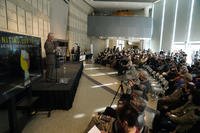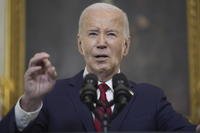After the Senate Appropriations defense subcommittee voted to whack spending for the F136 during its markup earlier this week we didn't hear much from the normally voluble folks at General Electric and Rolls Royce.
Today, they and their supporters came right back into the game. The first good news wedge for them came from the Government Accountability Office, which raised serious questions about the Defense Department's $2.9 billion cost estimate for the F136's development.
Here's the, excuse the pun, money sentence, describing the type of analysis on which OSD based its estimate: "This type of analysis is typically developed when a quick estimate is needed and limited information is available, and does not include the same level of fidelity and precision normally associated with a detailed, comprehensive cost estimate."
Today, Sen. Carl Levin, who requested the GAO study and has been a consistent and powerful advocate for the F136, issued a lengthy statement in response. Because it states the GAO findings in better prose than did the GAO, here it is:
"On the period of noncompetitive procurement, as noted in the GAO report, during the engine competition between the F100 and the F110 in the mid 1980s, the price of the alternate engine became competitive after only a single year of noncompetitive procurement. The DOD estimated cost of $747 million assumes that, since the underlying JSF development program has slipped 3 years, competitive purchases of the F136 would have to slip 3 years. However, as GAO points out, the F136 development program is only 7 months behind the contract schedule and 2 years of noncompetitive procurements could still allow sufficient time to complete the alternate engine development and qualify the engine. A reduction in the period of noncompetitive procurement would tend to reduce the estimated cost of the competition alternative, and tend to push the economic argument in favor of competition.
On the second point, GAO points out that competition and the pressures on the two engine teams might cause them to invest their own corporate funds, and thereby, the Government would not have to pay for a component improvement program, estimated by DOD to cost roughly $345 million. The GAO report also points out that a JSF Joint Program Office program management advisory group study concluded in 2002 that competition has the potential to offset or eliminate the need for Government funding for a component improvement program. If that were the case, it could also reduce the cost of competition, and tend to push the economic argument in favor of competition."
"I believe that both of these observations add to economic arguments in favor of competition, but I have long believed that the economic benefits are not the only argument in favor of competition. That is why I strongly supported enactment of the Weapons System Acquisition Reform Act of 2009 (WSARA), which, among its main directions to the Defense Department, calls for competition throughout the life cycle of major acquisition programs. Since the JSF program is the single largest DOD acquisition program, the JSF engine is a great place to begin implementing WSARA."
The chairman and ranking member of the House Armed Services acquisition panel joined Levin today in support of the program, penning a Dear Colleague letter to "strongly encourage" them to support the F136. Reps. Robert Andrews and Michael Conway repeat arguments they have made before, saying competition will deliver lower costs for the Joint Strike Fighter program's engines.








